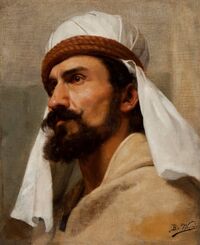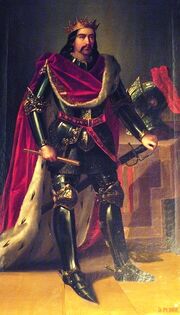That tells of the events after the victory of the Almohad at Navas de Tolosa, the further victories and advances of the Almohad, the quarrels between Castile and Leon up to the Peace of Valladolid and the triumphs of Aragon in Occitania
All starts with the Battle of Las Navas de Tolosa (16 July of 1212, 15 Safar 609 AH) the Christian Army was defeated by the Almohad. The military Order of Calatrava loses its Grand Master in the Battle. Of greater importance is the death of King Alfonso VIII of Castile in battle. The Kingdom plunged in despair and crisis under the regency of Eleanor Plantagenet.
The Castilian and Leonese Wars

Alfonso IX of León (1188-1226)

Eleanor Plantagenet, Regent of Castile (1212-1219)
However besides losing a King Castile had greater troubles and dire times. Alfonso IX of Leon pressed to regain his territorial claims by the arms with his army and Christian and Arab mercenaries starting th the first of the Castilian-Leonese Wars, in 1213. Eleanor Plantagenet has guardian of the heir Enrique I and a politically resourceful woman surrounded herself with loyal counselors and generals. The first moves of Leon meant a brief struggle to gain the control of Simancas from Castile, helped by a treacherous Leonese tribute offered to the Almohad to prevent an strike from them. After wining Simancas from Castile a brief truce was settled. However due to this early victory, Alfonso IX was now more ambitious and planned to have all or greater part of Castile has part of his dominions. The bellicose Almohad awaken after their victory presented a treat to Alfonso IX's plans. So he revived the old custom of the parias[1]. With this action he guaranteed a free hand to move his armies and retinues, relaying on the military orders to keep a check on truce of the parias.
Against the wishes of many court members but following wiser counsels Eleanor Plantagenet summoned the Cortes of Castile at Burgos in 1214. In exchange for the full approval of taxes and troops, Eleanor rose the number of the procurators thereby given more representation to towns and villages, the right to meet once a year at Burgos and the King's right to dismiss the Cortes. Besides approving new taxes and the right to rise troops, it also recognized the regency of Eleanor and crown rights of Enrique I of Castile.
To most observers by 1226 both kingdoms had exhausted their sources and war had come to a stand still. For León the prize of gaining full control Campos de Tierra had brought troubles in gaining full homage and the fealty from the former vassals of Castile. Fernando III was more engaged it gaining royalties and control then continuing a war that saw no further gains for León. In Castile, Enrique I had in his hands a rebellion of the nobles that opposed his rule.
Also the military weakness brought again the fear of further advances from the Almohad and a posible crossing of the Tangus, now established as a de facto limit of Christian and Muslim kingdoms. Neither Leon nor Castile had the resources to follow the calls for a new crusade called by the Pope, effectively ending the Reconquista for the time being and leaving Portugal to its own devices.
The Peace of Valladolid (1230) ended the Castilian-Leonese Wars. The terms established a truce between León and Castile and important territorial changes. León gained full control of Tierras de Campo and the towns of Carrión, Palencia and Plasencia in exchange of giving back Valladolid to Castile. Castile was the losing party, small confort was found by many nobles in the return of Valladolid. More serious were the land and river tolls imposed by León on the commerce coming and going to Tierras de Campo, restrictions on trade, and land requisitions in Tierras de Campo for those that did not swear loyalty to Fernando III.
The Spoils of Victory

Almohad Caliph Muhammad al-Nasir. Reign 1199-1230 (595-627 AH)
After his Victory, Caliph Muhammad al-Nasir looked to further consolidate his gains. The siege and recapture of Calatrava La Vieja ( Qal'at Rabah) and Malagon by Almohad and mercenary armies in 1212 (609 AH) established the control of this area for future campaigns. On his return to Ishbiliya (Sevilla) he called on his generals to plan the next campaign to regain Alentejo from Portugal.
So in 1214 (610-6111 AH) under his command he led the First Almohad Summer Campaign of Alentejo. Its gains were the recapture of Evora (Portuguese 1165-1214) and consolidation of southern half of Alentejo. It was also followed by the military expulsion of the Order of Aviz from Evora and to move its headquarters to Santarem.
However Muhammad al-Nasir had to turn his attention to North Africa, saving the Portuguese for the time from further military campaigns. In 1215 the Marinids (Banu Marin) rebelled and took control of Bugia, Argel and al-Mansoura. More alarming was the proclamation by Abd al-Haqq I, leader of the Marinids, of allegiance to the Abbasid Caliphate and disdain to the so called Almohad heretics. A center of dissident and resistance to Almohad orthodoxy came to being, so a mutual jihad was proclaimed.
In 1216 (613-614 AH) Muhammad al-Nasir, along his general Uzair al-Jasmir and Abu Zakariya Yahya governor of Ifriqiya, started the jihad against the despicable Marinids (1216-1218). The victory of Alger of the Almohad in 1218 ended the rule of the Banu Marin (Marinids) in Argelia. With his hands free again the campaigns (jihad) of Alentejo were restarted.
However the Caliph’s generals were not idle in Al-Andalus, also important were the victories at the sieges of Alcántara (August-September 1216) and Uclés (October 1216). Each were respectively the seat of the military orders of Alcantara and Santiago and their defeat meant their retreat to the north of Tagus river.
Greater news arrived from Al-Andalus. Taking advantage of the Castilian-Leonese Wars and a truce with the former kingdom, the Almohad recaptured Toledo (May 1219, Safar 616 AH) and ratified and consolidate their control of the southern bank of Tagus river. Followed later by the Second Almohad Summer Campaign of Alentejo (1219, 615-616 AH) that to the despair of the Portuguese meant further defeats and losses.
Victory of Muret and Cathar Crusade

Pedro II The Catholic of Aragón (1196-...)
For Pedro II The Catholic of Aragon the campaign and defeat of Las Navas de Tolosa had already settled his unwillingness to campaign in Spain. His main interest had been on Occitania. Returning to Aragon in 1212 he finds that Simon IV of Montfort had conquered Toulouse, exiling Count Raymond VI of Toulouse, who was Peter's brother-in-law and vassal. He decided to cross the Pyrenees and deal with Montfort at Muret. Arriving at Muret in September 1213 to confront Montfort's army. The siege of Muret was won when a the small contingent commanded by Montfort attacked the Aragonese forces the 13th in order to lift and escape the siege. In combat Montford is killed causing his forces to dispel and surrender Muret. Pedro II's victory leaves him has overlord of great part of the Languedoc. He negotiated with the papal delegate to continue and command the Albigensian Crusade in exchange of the repealment of the papal excommunication and recognition of his suzerainty of Toulouse, Montpellier, Foix and Provence. Culminating in 1220 (616–617 AH) when the Estats de Toulouse were summoned by Pedro II The Catholic of Aragón to assembled for the first time. Its first business of the day was to recognize the suzerainty of the Crown of Aragón in Occitania.
Under pressure and demands from his Aragonese vassals and merchants, Pedro II commanded the siege of Castellon. Its victory (November 1216) and short reach[2] from Balansīa (Valencia) was appropriate for continuous raids to its countryside and strangle its defenses and resources. In vain for the time being did the Arab governor of Balansīa plead for help from the Caliph.
The Valencian Levant
Having organized his domains and vessels in Occitania and under pressure from the nobles and prelates of Aragón, Pedro II resumed his oath to Crusade against the Muslims. From the footholds of Castellon and Teruel several raids were made against the Almohad, However Pedro II waited until better times and meanwhile built forts and organized his armies for a major campaign that would included the capture of the Balearic Islands.
His patience yielded fruits when the Western Miḥnah Consolidation broke up in many rebellions in Algeria, Maghreb and parts of Al-Andalus and Ifriqiya. So in 1242 Pedro II marched from Castellon plundering the countryside and laying siege to Valencia. From Teruel troops also marched down to Valencia. Although the rebellions in the Almohad Empire impaired a swift response to the threat of Aragonese, as troops and cavalery were employed in securing cities and crushing uprisings what Pedro II did not count was in the obstinate resistance of Valencia and two accomplished Almohad commanders, Emir Abdul ibn Maarufi and his son Yussuf.
New gains and contacts
Out of the Almohad domains of Morocco, Argelia, Ifriqiya, Al-Andalus and Balearic Islands laid other people and lands. For example the Eternal Islands (Al-Jaza'ir al-Khalidat)[3], occasionally visited by Muslim ships and sailors and some Christians. The Eternal Islands are inhabitant by the Guanches, indigenous people of Berber extraction. On the knowledge of their existence the Caliph decided to spreadd the word and book of God to them and give them his protection. So in the 1250s the Kingdoms[4] of the Canary Island became vassals of the Almohad and were place under its protection and commerce.
The main Sahelian Muslim polities (Mali and Songhai Empires) had long established commercial ties with the Maghreb, and also diplomatic contacts exchanging scholars and learning. An important event and that also marked further involvement in the trade and politics of the Sahel polities was the establishment of trade factories in Ndar[5] (1242, 640 AH) and Takrur (1244, 642 AH) on the Senegal river.
Maps
| ||||||||||||||||||||




